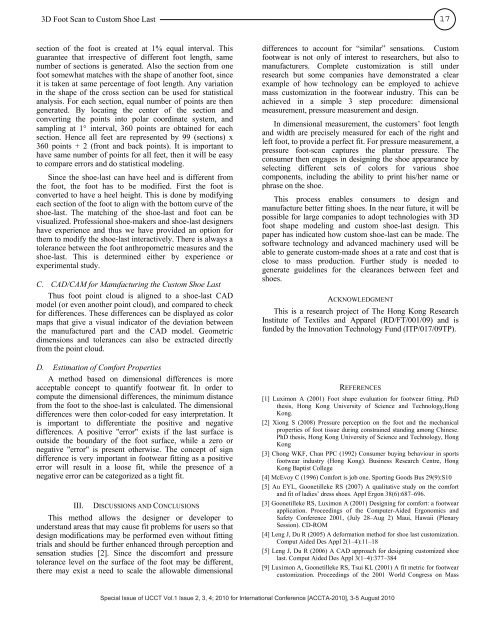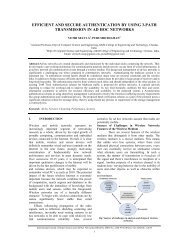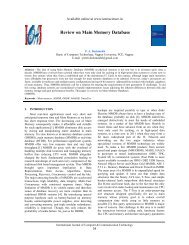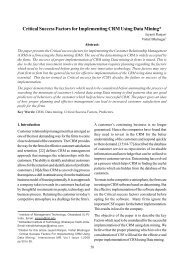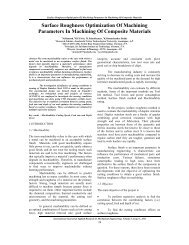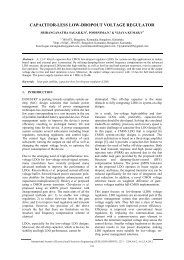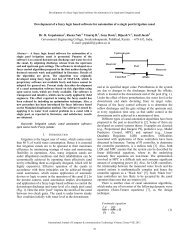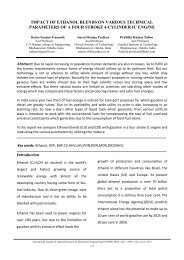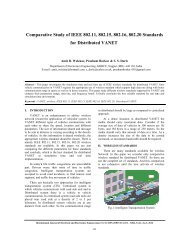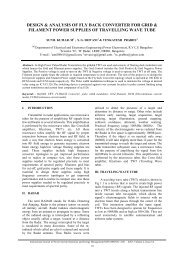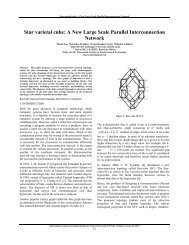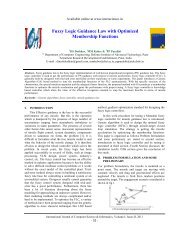3D Foot Scan to Custom Shoe Last - ResearchGate
3D Foot Scan to Custom Shoe Last - ResearchGate
3D Foot Scan to Custom Shoe Last - ResearchGate
Create successful ePaper yourself
Turn your PDF publications into a flip-book with our unique Google optimized e-Paper software.
<strong>3D</strong> <strong>Foot</strong> <strong>Scan</strong> <strong>to</strong> Cus<strong>to</strong>m <strong>Shoe</strong> <strong>Last</strong>17section of the foot is created at 1% equal interval. Thisguarantee that irrespective of different foot length, samenumber of sections is generated. Also the section from onefoot somewhat matches with the shape of another foot, sinceit is taken at same percentage of foot length. Any variationin the shape of the cross section can be used for statisticalanalysis. For each section, equal number of points are thengenerated. By locating the center of the section andconverting the points in<strong>to</strong> polar coordinate system, andsampling at 1 interval, 360 points are obtained for eachsection. Hence all feet are represented by 99 (sections) x360 points + 2 (front and back points). It is important <strong>to</strong>have same number of points for all feet, then it will be easy<strong>to</strong> compare errors and do statistical modeling.Since the shoe-last can have heel and is different fromthe foot, the foot has <strong>to</strong> be modified. First the foot isconverted <strong>to</strong> have a heel height. This is done by modifyingeach section of the foot <strong>to</strong> align with the bot<strong>to</strong>m curve of theshoe-last. The matching of the shoe-last and foot can bevisualized. Professional shoe-makers and shoe-last designershave experience and thus we have provided an option forthem <strong>to</strong> modify the shoe-last interactively. There is always a<strong>to</strong>lerance between the foot anthropometric measures and theshoe-last. This is determined either by experience orexperimental study.C. CAD/CAM for Manufacturing the Cus<strong>to</strong>m <strong>Shoe</strong> <strong>Last</strong>Thus foot point cloud is aligned <strong>to</strong> a shoe-last CADmodel (or even another point cloud), and compared <strong>to</strong> checkfor differences. These differences can be displayed as colormaps that give a visual indica<strong>to</strong>r of the deviation betweenthe manufactured part and the CAD model. Geometricdimensions and <strong>to</strong>lerances can also be extracted directlyfrom the point cloud.D. Estimation of Comfort PropertiesA method based on dimensional differences is moreacceptable concept <strong>to</strong> quantify footwear fit. In order <strong>to</strong>compute the dimensional differences, the minimum distancefrom the foot <strong>to</strong> the shoe-last is calculated. The dimensionaldifferences were then color-coded for easy interpretation. Itis important <strong>to</strong> differentiate the positive and negativedifferences. A positive "error" exists if the last surface isoutside the boundary of the foot surface, while a zero ornegative "error" is present otherwise. The concept of signdifference is very important in footwear fitting as a positiveerror will result in a loose fit, while the presence of anegative error can be categorized as a tight fit.III.DISCUSSIONS AND CONCLUSIONSThis method allows the designer or developer <strong>to</strong>understand areas that may cause fit problems for users so thatdesign modifications may be performed even without fittingtrials and should be further enhanced through perception andsensation studies [2]. Since the discomfort and pressure<strong>to</strong>lerance level on the surface of the foot may be different,there may exist a need <strong>to</strong> scale the allowable dimensionaldifferences <strong>to</strong> account for “similar” sensations. Cus<strong>to</strong>mfootwear is not only of interest <strong>to</strong> researchers, but also <strong>to</strong>manufacturers. Complete cus<strong>to</strong>mization is still underresearch but some companies have demonstrated a clearexample of how technology can be employed <strong>to</strong> achievemass cus<strong>to</strong>mization in the footwear industry. This can beachieved in a simple 3 step procedure: dimensionalmeasurement, pressure measurement and design.In dimensional measurement, the cus<strong>to</strong>mers’ foot lengthand width are precisely measured for each of the right andleft foot, <strong>to</strong> provide a perfect fit. For pressure measurement, apressure foot-scan captures the plantar pressure. Theconsumer then engages in designing the shoe appearance byselecting different sets of colors for various shoecomponents, including the ability <strong>to</strong> print his/her name orphrase on the shoe.This process enables consumers <strong>to</strong> design andmanufacture better fitting shoes. In the near future, it will bepossible for large companies <strong>to</strong> adopt technologies with <strong>3D</strong>foot shape modeling and cus<strong>to</strong>m shoe-last design. Thispaper has indicated how cus<strong>to</strong>m shoe-last can be made. Thesoftware technology and advanced machinery used will beable <strong>to</strong> generate cus<strong>to</strong>m-made shoes at a rate and cost that isclose <strong>to</strong> mass production. Further study is needed <strong>to</strong>generate guidelines for the clearances between feet andshoes.ACKNOWLEDGMENTThis is a research project of The Hong Kong ResearchInstitute of Textiles and Apparel (RD/FT/001/09) and isfunded by the Innovation Technology Fund (ITP/017/09TP).REFERENCES[1] Luximon A (2001) <strong>Foot</strong> shape evaluation for footwear fitting. PhDthesis, Hong Kong University of Science and Technology,HongKong.[2] Xiong S (2008) Pressure perception on the foot and the mechanicalproperties of foot tissue during constrained standing among Chinese.PhD thesis, Hong Kong University of Science and Technology, HongKong[3] Chong WKF, Chan PPC (1992) Consumer buying behaviour in sportsfootwear industry (Hong Kong). Business Research Centre, HongKong Baptist College[4] McEvoy C (1996) Comfort is job one. Sporting Goods Bus 29(9):S10[5] Au EYL, Goonetilleke RS (2007) A qualitative study on the comfortand fit of ladies’ dress shoes. Appl Ergon 38(6):687–696.[3] Goonetilleke RS, Luximon A (2001) Designing for comfort: a footwearapplication. Proceedings of the Computer-Aided Ergonomics andSafety Conference 2001, (July 28–Aug 2) Maui, Hawaii (PlenarySession). CD-ROM[4] Leng J, Du R (2005) A deformation method for shoe last cus<strong>to</strong>mization.Comput Aided Des Appl 2(1–4):11–18[5] Leng J, Du R (2006) A CAD approach for designing cus<strong>to</strong>mized shoelast. Comput Aided Des Appl 3(1–4):377–384[9] Luximon A, Goonetilleke RS, Tsui KL (2001) A fit metric for footwearcus<strong>to</strong>mization. Proceedings of the 2001 World Congress on MassSpecial Issue of IJCCT Vol.1 Issue 2, 3, 4; 2010 for International Conference [ACCTA-2010], 3-5 August 2010


